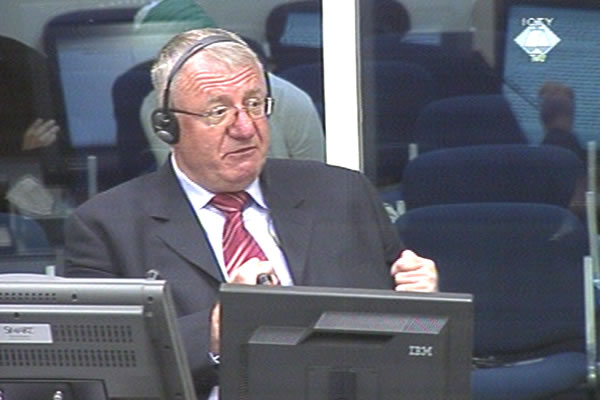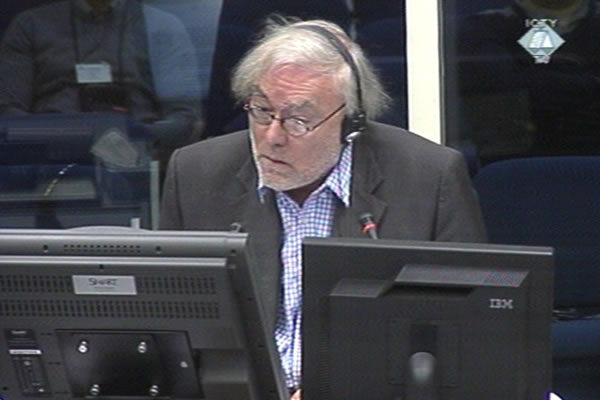Home
FRENCH AND SERB NATIONALISTS DEFEND KARADZIC
In a bid to defend Karadzic, Vojislav Seselj attacked ‘the crazy woman’ Biljana Plavsic, ‘Chetnik vojvoda’ Tomislav Nikolic and ‘Chetnik volunteer’ Aleksandar Vucic. He praised the recent Tribunal’s judgments acquitting Stanisic, Simatovic and Perisic. After Seselj completed his evidence, French historian Yves Bataille claimed that there was no massacre in Srebrenica. In mid-July 1995 he met with Karadzic at Pale and Karadzic was so “relaxed” that there was no indication that any crimes may be happening in Srebrenica
 Vojislav Seselj, defence witness of Radovan Karadzic
Vojislav Seselj, defence witness of Radovan Karadzic Continuing his evidence in Radovan Karadzic’s defense, Serbian Radical Party leader Vojislav Seselj didn’t renounce any of his extremist views. At the same time Seselj claimed that before and during the war he had supported the accused and the Bosnian Serb leadership in all ‘key issues’. This was exactly what prosecutor Alan Tieger, who cross-examined the witness, had been trying to prove: that Karadzic was close with the nationalists who wanted the war and that they were in effect accomplices.
Prosecutor Tieger showed a number of Seselj’s pre-war statements in which he threatened Croats that he would avenge the World War II victims and warned Muslims not to interfere in the Serb-Croat conflict. The revenge would ‘be terrible’, Seselj said, adding that he would ‘expel them all the way down to Anatolia’. The witness didn’t take back the statements; he explained that they were ‘threats meant as a warning’. He told the Croats and Muslims what would happen if the war broke out. According to Seselj, his predictions came true, especially as regards Muslims who ‘suffered the most’ during the war in BH.
Describing the involvement of his volunteers in the conflict, Seselj said that at the first stage they operated ‘illegally’. The volunteers were transferred to Croatia over the Danube river carrying arms that had been taken secretly from the military depots. The second phase was ‘legal’, as ‘Seselj’s men’ went to the battlefields under the JNA command. One such action was the attack on Zvornik in the spring of 1992. In Seselj’s words, the operation had been ‘prepared and planned for a long time in Belgrade’. Seselj claimed that Karadzic wasn’t involved in the operation that was followed by a number of crimes against local Muslims.
The Serbian Radical Party leader didn’t deny that the Serb armies in Bosnia and Krajina received support from Belgrade. However that was not a crime, Seselj argued, invoking the Tribunal’s recent judgments. As Seselj noted, the Tribunal acquitted Jovica Stanisic and Franko Simatovic who provided ‘police and intelligence support’, and General Momcilo Perisic, who was in charge of ‘military support’.
In the re-examination Karadzic wanted to show that their ‘mutual respect’ could create ‘the wrong impression’ that they were allies. He asked Seselj to list their differences. The witness noted that he was against Karadzic’s 1993 agreement with the Bosnian Croat leader Mate Boban. Seselj had advised Karadzic to side with the Muslims against Croats. Also, after the war Seselj recommended to Karadzic not to nominate Biljana Plavsic for president. In Seselj’s opinion, Plavsic was ‘crazy, abnormal and amoral’.
When Karadzic asked Seselj if his former closest associate in the party, the incumbent Serbian president Tomislav Nikolic, had known anything about the events in BH, Seselj replied that they had worked together. ‘If I am involved in the war crimes, then he is a direct accomplice’, Seselj said. Seselj also recalled that in 1993 he bestowed the Chetnik rank of vojvoda on Nikolic. It would be interesting to see ‘a Chetnik vojvoda inspect the Ustasha guard of honor’ at the forthcoming visit to the Croatian president Ivo Josipovic, Seselj said. Nikolic spent two months as a volunteer in Slavonia, Seselj added. Seselj also said that before joining the Radical Party, Serbian deputy prime minister Aleksandar Vucic was in Slavko Aleksic’s Chetnik detachment in Sarajevo.
Another out-and-out nationalist appeared in the witness stand after Seselj completed his evidence: French historian Yves Bataille. Because he married a Serb woman, Bataille developed an interest in the conflicts in the Balkans. He concluded that the international community had caused the war and that the Western propaganda blamed the Serbs for everything. The issue of the Srebrenica genocide is, in Bataille’s view, a result of this propaganda. According to Bataille, there was no genocide in Srebrenica. Bataille reached this conclusion based on his first meeting with the accused at Pale on 17 July 1995. In his statement to the defense, Bataille stated that at the meeting ‘no mention was made of the executions in Srebrenica’. Karadzic was ‘relaxed’ and nothing in his behavior indicated that any crimes were being committed against the Srebrenica Muslims, Bataille told the defense.
In the cross-examination, the prosecutor asked Bataille if he really thought that someone involved in a mass killing would confide about it to a man he saw for the first time in his life. Bataille first claimed he didn’t understand the question, and then said the suggestion was ‘tendentious and malicious’. According to the French intellectual, Seselj and Karadzic are ‘Serb heroes’. Bataille didn’t deny that he acted as a mediator between the Serbian Radical Party leader and French nationalist Jean-Marie Le Pen and that the accused had awarded him a medal during his visit to Pale.
After the Serb and French intellectuals completed their evidence, the accused called Dusan Kovacevic, former Republika Srpska defense minister. He will continue his evidence tomorrow.
Photos
Linked Reports
- Case : Karadzic
- 2013-06-07 SESELJ’S THREATS STILL VALID
- 2013-06-07 EXECUTIONS ‘IN WAVES’
- 2013-06-06 ROLE OF ‘FRUIT PICKERS’ IN SREBRENICA MASSACRE
- 2013-06-11 KARADZIC’S WITNESSES BLAME MLADIC’S ‘MILITARY CLIQUE’
- 2013-06-12 AMBASSADOR DENIES GENOCIDE AND MOCKS VICTIMS
- 2013-06-13 WHEN DID ‘WHISPERS’ ABOUT CRIMES IN ZVORNIK REACH KARADZIC?

